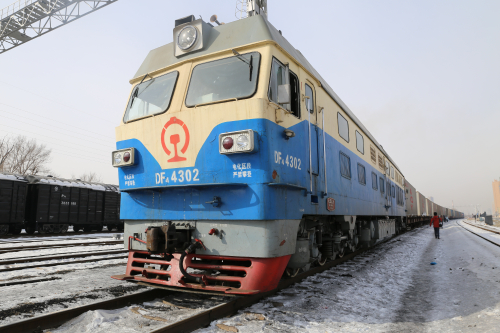|
 |
|
TO RUSSIA WITH LOVE: The first regular cargo train service linking northeast China's Heilongjiang Province to central Russia leaves on its maiden voyage on February 28. The cargo train, carrying oil exploration equipment, pulled out of Xiangfang Railway Station in the provincial capital of Harbin, arrived in Biklyan, Russia, in 10 days (LI SHUO) |
Rare Earth Exchange
China's first rare earth exchange has operated well in its first year, turning over more than 35,000 tons of products.
The trading volume of the Baotou Rare Earth Products Exchange, launched in March 2014 in Baotou, north China's Inner Mongolia Autonomous Region, reached 5.6 billion yuan ($910 million) at the year's end, said Gu Ming, general manager of the exchange.
Ninety-five rare earth firms and traders in about half of China's provinces have opened accounts with the exchange, an electronic platform created to help regulate the domestic rare earth industry and improve its transparency, Gu said.
The exchange was initiated by China North Rare Earth Group Co. Ltd., the country's leading rare earth producer, and another 12 firms and institutions with a registered capital of 120 million yuan ($19 million).
It has three spot transaction modes: price bidding, listed trading and real-time trading online, with trading items including cerium oxide, praseodymium-neodymium oxide and europium oxide.
Fly Like 5G Technology
If events at the 2015 Mobile World Congress (MWC) currently held in Barcelona from March 2 to 5 were anything to go by, Chinese telecom firms, including Huawei, look certain to lead the development into 5G technology.
The Internet of Things and the Internet of Vehicles were much-discussed topics in Barcelona, and it is obvious that the 4G network simply isn't going to be enough to carry the estimated 100 billion Internet connections that are needed, something Huawei's acting CEO, Ken Hu has described as "a huge challenge to the mobile industry."
"Everything will be connected: our toothbrushes, our sneakers, glasses, watches as well as forklifts and robotic arms used in factories," said Hu, stressing that 5G, with a capacity 1,000 times greater and an estimated 100 times faster than current 4G networks, can make that connected future possible, providing the speed needed for self-driven vehicles, for example.
At the MWC, Huawei signed a collaboration agreement with Japan's major mobile operator DOCOMO for both companies to test 5G remote access technology in the latest of a series of agreements with countries from all around the globe. Huawei backed the commitment further, announcing plans to invest at least $600 million in research and development in the technology over the next three years.
Rise in Service
The Yangtze River Delta is exhibiting a more service-based economy, as the service sector for the first time became the region's largest economic sector last year.
According to a report released on March 2 by the Statistics Bureau of Wuxi, east China's Jiangsu Province, the tertiary industry of the region's 16 major cities' added value reached 5.43 trillion yuan ($882.9 billion) in 2014, accounting for 51.2 percent of the total GDP, compared with the secondary (45.8 percent) and primary (3 percent) sectors.
The report analyzed that the region had stepped up economic restructuring in recent years under pressure from shrinking resources, deteriorating environment and rising labor costs. The tertiary industry, also known as the service industry, will be a new driving force of regional development, it said. |
